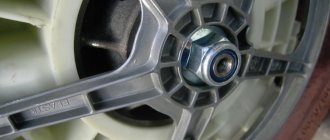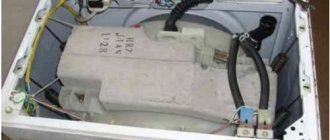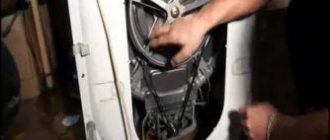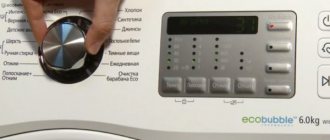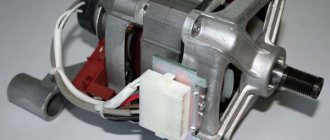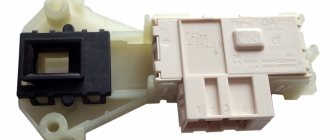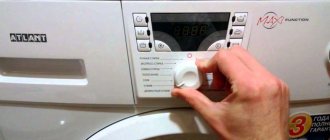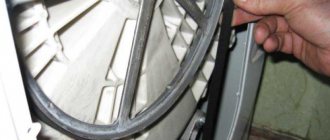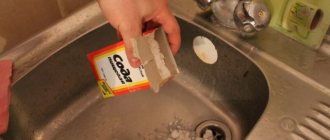Anyone can determine that a bearing in a washing machine needs to be replaced. It doesn’t matter what brand - Samsung or another model. Bearings break, usually gradually. And noise begins to arise during washing, and in the spin mode it becomes unbearable. The machine often vibrates and moves. Buying special pads for the legs does not solve the problem. Sometimes the drive belt slips. You can do this work yourself, without the involvement of a specialist, if you have the desire and the necessary tools. Let's look at the example of the Samsung Diamond model.
- Determining the need for replacement
- Sequence of repair actions
- Disassembling the Samsung washing machine
- Removing the tank and bearings
- Installation
- Assembling a Samsung washing machine
- Samsung washing machine catalog
Determining the need for replacement
You can diagnose that the bearings are worn out as follows:
- Open the hatch and turn the drum manually. If you hear a characteristic crunch, as if something is rattling, as if over bumps, then the problem is in the bearings.
- After opening the hatch, grab the edges of the drum with your fingers and try to move it. If it moves up and down by 5 mm or more, then the bearings or crosspiece are worn out.
To make sure that the problem is in production, you need to remove the back cover. Spin the drum and listen near the pulley. You can take off the belt, then only the bearing will be heard.
This is what the washing machine looks like with the lid removed.
Replacing the bearing on the drum of an Ariston washing machine. Stage-by-stage execution of work
We will tell you how to change the bearing in an Ariston washing machine. Disassembly of the SM will be identical for Hotpoint Ariston Aqualtis, Hotpoint Ariston ARSL 105, Ariston Margarita 2000 and other models.
Covers and panels
Take a Phillips screwdriver. Walk around the washer, standing towards the back wall. Remove the two bolts that secure the top cover. Then slide it forward and remove it from the body.
Proceed to the back panel. Unscrew the screws around the perimeter and set the cover aside. At the same time, remove the drive belt - turning the pulley by hand, pull it towards you.
Control Panel
Go to the front of the washer. Pull out the detergent dispenser: pull the tray towards you by pressing the lock in the center; take it out and put it aside. There are several bolts behind it, and another 1-2 bolts on the opposite side of the panel. Unscrew them and unfasten the plastic latches.
Now the panel is supported only by the wires - you can throw it on top of the case. But if you decide to disconnect, it’s better to immediately take a photo of the location of the connectors for proper connection.
Top part
You need to remove anything from the top of the tank that might interfere with its removal. This:
- Powder receiver. Loosen the clamp on the pipe leading from the hopper to the tank. Remove the pipe. Disconnect the inlet valve contacts and unscrew the fastening screws. Remove the valve together with the powder receptacle.
- Counterweight. Unscrew the bolts securing the upper counterweight and remove it.
- Pressostat. Disconnect the pressure switch hose that is attached to the tank, otherwise it may break during dismantling.
Front Panel
Open the hatch door. Having bent the sealing rubber, use a screwdriver to pry up its clamp and pull it out of place.
Unfasten the hatch lock wiring (UBL) by placing your hand behind the body. First unscrew the two mounting bolts.
If you are afraid of damaging the door glass, we recommend removing it immediately. To do this, unscrew the screws that secure the door hinges and set it aside.
All that remains is to unscrew the screws around the perimeter of the front panel and remove it. Now unscrew the lower counterweight bolts to remove it.
Rear end
Disconnect the wiring from the electric motor at the bottom of the tank. Unscrew the bolts (three to four pieces), move the engine first forward, then pull it back and remove it from the housing.
Disconnect the heating element wiring. The heater itself does not need to be dismantled. If you damage its sealing rubber, you will have to completely change everything.
Also, if there is wiring attached around the perimeter of the tank, use wire cutters to cut the clamps and move the wires to the side.
Shock absorbers
The tank is secured only by shock absorbers and hanging hooks. Unscrew the shock absorber screws, remove the tank from the hooks and pull out the tank.
You have disassembled the washing machine. Now you need to get to the bearings.
Online diagnostics of a washing machine
If your machine stops washing or rinsing clothes normally, then some kind of malfunction or breakdown has occurred.
You can try to find the problem yourself. Run diagnostics
Select which operation your washing machine does not perform:
1. Doesn’t drain 2. Doesn’t rotate the drum 3. Doesn’t spin clothes 4. Noises, knocks, buzzes when spinning 5. Doesn’t turn on
Checking the operation of the drain pump Is the drain pump of the washing machine working? Yes No I don’t know << Back
Clogged hoses in the washing machine If the sound corresponds to the normal sound that has always been observed when the device is working, the cause is probably a clog.
Was there a blockage in the drain hose? Yes
<< Back
The drain pump does not work! If the sound matches the normal sound of the drain pump, it is recommended that you check the drain filter first.
After cleaning, does the drain pump work and does the washing machine drain water? Not really
<< Back
Operation of the drain pump The sound of the pump is usually immediately audible and noticeable. If there is no sound, the pump is not working. We are looking for how to separately enable the water drainage program. As a rule, this is a separate option. After the program has been turned on, the pump should start working in 1-3 seconds. If everything is done correctly and the pump is operational, a buzzing sound will appear. If you hear no buzzing or other sounds when you turn on the program, the pump is probably faulty.
Is the washing machine drain pump working? Not really
<< Back
Clogged car hoses If you have identified a clog in the hoses, you need to disassemble them, clean them, and then reassemble everything.
Does the washing machine drain well? Not really
<< Back
Hurray, you did a great job, you fixed it.
<< Return to the beginning of diagnostics
The drain pump is faulty, call a professional.
<< Return to the beginning of the diagnosis.
The washing machine does not rotate the drum. During the operation of the washing machine, such a problem may occur. Each model has a different drum operation. It rotates according to a given algorithm, which is set by the program. This principle applies to spinning and washing. If you are not sure whether the drum is not spinning or whether it is working, put the laundry in the washing machine. Start the spin program. If the machine is running, it will first drain the water and then start spinning. In this case, a rotational process will be observed. If rotation is not visible, then check the belt. First, turn off the program, then unplug the wire from the outlet so that power does not flow into the device. Now you need to remove the back cover. You will need to carefully inspect the drum belt. It is quite easy to determine whether it is in the wrong position or damaged.
Is the washing machine belt torn or stretched? Not really
<< Back
Broken drum drive belt If the belt breaks, it will be immediately visible. There are also often cases when the belt simply stretches, which is why the drum, accordingly, does not rotate. Do not allow the machine to operate if the belt breaks. It is important to check whether it has wound around the engine pulley or broken the wiring to the engine. The heating element and temperature sensor may also be damaged if the belt does catch the wires. It is imperative to ensure that the belt model is original. If you choose an unsuitable or low-quality product, this will affect the performance of other devices. How do you know what kind of belt you have? There will be a marking written on the old one, compare it with the one indicated on the belt offered to you. You can also find out belt information by car model.
<< Return to the beginning of the diagnosis.
Washing machine motor malfunction If a malfunction is not found, the block with wires must be disconnected from the electric motor. Carefully remove it. We visually evaluate the engine. It may have melting, cracks, or other effects that clearly indicate damage. We call the windings of the tachogenerator and the engine. It is important to understand that you can fully study how correctly the engine operates and whether there is a malfunction only at the stand. If rotation does not occur, there may be a problem with more than just the motor. Sometimes the cause is a malfunctioning electronic module. If a short circuit occurs in the engine, the module could be damaged, while the engine remains operational. Also, the wires could be damaged.
<< Return to the beginning of the diagnosis.
Repairing a washing machine that does not spin clothes After completing the washing process, the washing machine may not spin properly or may not start spinning. Firstly, look, perhaps another mode is set, which does not involve turning on the spin cycle at all. This happens, for example, with programs related to washing woolen items and delicate fabrics. To check, run the spin cycle separately. If the washing machine does not drain water, we proceed to check the pump.
Does the washing machine now spin clothes? Not really
<< Back
Congratulations, you have solved your problem!
<< Return to the beginning of the diagnosis.
Repair of washing machines, imbalance Modern washing machines place the laundry on the drum before spinning. This is necessary for quality work. Check if this feature works. Sometimes a situation occurs when things get wrapped up in a ball that cannot be unwound automatically within a certain time. At this point the work stops. You need to unwind this laundry yourself, lay it out and continue operating the washing machine. In this case, it is important to turn off the machine, and then, when the laundry is laid out, turn on a separate spin program.
Does the washing machine now spin clothes? Not really
<< Back
Washing machine repair, drum drive repair Now you need to check the drum drive belt. We remove the cover and visually assess the condition of the belt. There should be no damage. If the tension is weak, the spin may not turn on. If you need to replace the belt, you should only replace it with the original one. After replacing, we try the program again.
Fault found, does the washing machine spin? Not really
<< Back
The engine or electronic module is faulty, call a repairman to your home.
<< Return to the beginning of the diagnosis.
The washing machine hums, makes noise during the spin cycle, rumbles, and makes a jet plane noise. If the washing machine makes noise during operation, making unusual sounds, it’s time to pay special attention to it. In this case, a visible breakdown or lack of functionality may not be observed, but the appearance of strange sounds indicates that it is time to look for a malfunction. It is important to understand that a new car that has just been delivered should be inspected for shipping bolts. If you forget to remove them, noise and vibration are inevitable. So, let's begin! We turn the washing machine drum and listen to extraneous sounds.
When rotating, do you hear extraneous noise, hum, balls rolling, does the drum move unevenly with slight jamming? Not really
<< Back
If the drum rotates and uncharacteristic sounds appear, including vibration, it’s time to check the bearings. If they malfunction, they will have to be replaced.
<< Return to the beginning of the diagnosis.
The counterweight of the washing machine has come loose. The fastening of the counterweights must also be of high quality. If they are “loose”, it’s time to eliminate this defect. In some cases, you can notice that the bolts that secure the stones are completely missing. In this case, the connectors for mounting will be visible. The bolts need to be found and put in place - they probably simply came loose. A rumble heard while the washing machine is operating may indicate that the bolts have partially loosened. To check the bolts, you can simply push the drum. If it is secure, the bolts are fine. If it moves, there is a defect.
Do you hear any noise, clanging or rattling noises when moving the washing machine tub? Not really
<< Back
The counterweight has come off
<< Return to the beginning of diagnostics
Checking the shock absorbers of the washing machine Checking the shock absorbers. If you hear vibration or excessive noise during the spin cycle, there may be a problem with the shock absorbers. Sometimes the washer moves. Now let's check the functionality. Remove the top cover. Click on the tank, move it five to seven centimeters down. A normal reaction will be observed if the tank rises sharply, jumping a little and stopping in its normal place. If this does not happen, the shock absorbers need to be replaced.
Are the shock absorbers of the washing machine working? Not really
<< Back
If a visible defect has not been identified, check whether a foreign object may have entered the machine. Replacing shock absorbers. The problem with shock absorbers wearing out occurs quite often over time.
<< Return to the beginning of the diagnosis.
Replacing washing machine shock absorbers. Malfunction and wear of shock absorbers is a fairly common phenomenon.
<< Return to the beginning of the diagnosis.
The washing machine does not turn on. It is worth trying to find the cause of the problem yourself and fix it. We start by connecting the device to the network. Next, click on the “network” button. In different car models, different indications are triggered: here either the display will start working, or, on the contrary, some other button.
Does the washing machine have an indicator? Not really
<< Back
Hatch lock lock (UBL) You can check it by turning on any of the programs. We choose what we will use. Click on the corresponding button. Don't forget to pay attention to the inclusion. As a rule, the process of activating a function is characterized by the presence of a certain sound, for example a click, with which the device makes it clear that pressing again is not necessary and the machine is already working. If there is no sound, the button may be broken. In this case, the main thing that must be done is to block the hatch and start working. If this happens, everything is fine.
The washing machine is blocking the hatch and the UBL is triggered? Not really
<< Back
Water fill valve malfunction
<< Return to the beginning of the diagnosis.
The washing machine hatch does not lock
<< Return to the beginning of the diagnosis.
No indication Checking the electrical circuit. If you notice that the washing machine does not respond to being turned on, it is first recommended to check the power supply. The outlet may be faulty. Try connecting another device. If the outlet works, you need to check whether the circuit that conducts energy through the washing machine from one element to another is intact. To do this, you will need a multimeter, which will help you fully analyze the ability to respond to an electrical signal at several stages of operation. If there is no network connection anywhere, this is probably the problem. We carry out this manipulation until we reach the electronic module. If we are talking about an old washing machine, here it will look like the device’s program. When you turn on the button, there should be no breaks in the circuit. If the circuit works, everything is fine electrically.
Is the washing machine's power supply OK? Not really
<< Back
Repair of electronic module (unit)
<< Return to the beginning of diagnostics
Contact circuit fault
<< Return to the beginning of diagnostics
If you do not change it in time, the situation will worsen. The fact is that backlash occurs when the drum rotates. And this is the cause of two additional damages that will lead to an increase in the cost of repairs.
- First problem. The bearings are pressed into their seats. In the case of the washing machine that we are considering in the article, they are pressed directly into the plastic tank. And operating a machine with worn bearings leads to the destruction of these seats.
They can break to such an extent that it will be impossible to install new ones. In this case, the entire tank will need to be replaced. And this is another cost of repairs.
- Second problem. Shaft destruction or damage. In our machine it is connected to a cross, which is attached to the drum. The shaft rotates inside the bearings, and if they operate with play, this will lead to shaft wear.
As a result, you will additionally have to change the tank crosspiece. Difficulties may arise in finding it. Some models are difficult to find and must be ordered from suppliers in Europe or China. Wait - 2-3 months!
In this Samsung Diamond washing machine we are changing the bearings.
Removing the body panels of the washing unit one by one
Owners of modern equipment often have a question about how to change the bearing on a Samsung Diamond washing machine (6 kg). This is a fairly popular model, affordable for almost everyone. Dismantling work must begin as follows:
1. Removing the top panel.
The master will:
- use a screwdriver to unscrew the bolts located on the rear side of the housing;
- Carefully slide the panel and remove it.
2. Disconnecting the control panel.
To do this you need:
- Remove the pull-out tray intended for detergents. To do this, pull it out and press the latch located in the middle cell of the tray.
- Unscrew the two screws located on the surface of the control panel.
- Unscrew the three self-tapping screws that secure the internal base. They are located on the metal frame of the unit.
- Unscrew the screws connecting the control unit to the front panel and the device body.
- Pull the control panel in one direction (toward you), and pull the dispenser tank in the opposite direction. This will cause the dispenser to become detached from the base.
Do not completely disconnect the control unit. You can leave it on the plane of the case, since it is quite possible to change the bearing on a Samsung washing machine (4-5 kg) without completely dismantling it. It will not interfere with removing the tank from the housing.
3. Removing the narrow panel. It is located at the bottom of the case on the front side.
4. Removing the front housing cover.
Necessary:
- Unscrew the screws that secure the inner plane of the base, where the container for powdered products is installed.
- The rubber cuff located between the round bases of the hatch and the drum must be removed. To do this, bend the rubber part and lightly engage the clamp with a screwdriver. Remove it and put it aside with the removed parts.
- Unscrew the fastening elements located on the front part of the case (3 pieces at the top, 4 pieces at the bottom).
- We remove the panel. The process of detaching the panel from the body must be carried out with extreme caution to prevent mechanical damage to the plastic latches.
- Disconnect the electrical connector from the door lock element.
- Place the removed panel aside.
Sequence of repair actions
The required spare parts for a specific model can be found in the correspondence table.
All work can be divided into several large steps:
- It is necessary to remove the tank from the washing machine, having first disconnected and unscrewed all the attached elements from it.
- It is necessary to disassemble the tank and knock out the bearings and seal.
- Buy new ones and install them in the seats.
- Place the tank back into the washing machine, and hang and connect all the equipment.
These are the main stages, you can break them down into smaller ones. After completing the replacement, you need to check the operation of the washing machine in all modes, and be sure to make sure there are no leaks.
View with the top panel removed.
Dependence of the performance of washing equipment on the bearing
The performance of the washing machine will depend on the quality functioning of the bearings, since it is these parts that carry out the function of uniform rotation of its drum. Two bearings are installed in the units, and their location is the inner plane of the tank. They are not the same size and therefore carry different loads. If the bearing fails, the quality of the “Wash” and “Spin” options will immediately change. In this case, the question arises of how to change the bearing on a Samsung washing machine, because further use of the device can lead to more serious damage.
Disassembling the Samsung washing machine
First, remove the top cover by first unscrewing two screws. Then slam your palm down on the front. It will come out of the latches and can be easily removed.
Remove the counterweight, which is located on the top of the tank. To do this, we will use a size 10 socket wrench with an extension. Usually there are no problems here.
Tank with counterweight removed.
It is necessary to remove the front panel with the control unit and buttons. To do this, first remove the container for washing powder from the dispenser tank: pull it out and press the button highlighted in blue.
By pulling the dispenser, it will come out without any visible effort. Two self-tapping screws will become available, which are screwed through the front panel to the dispenser tank, ensuring the tightness of the structure.
We remove three screws from the top - they secure the dispenser tank to the metal body. Then we unscrew the screws that connect the front panel with the control unit to the frame of the machine.
The photo shows screws that need to be unscrewed (above and top right).
After this, pull the panel with the module towards you, and the dispenser tank in the other direction. It should disconnect.
Next we need to pull out the front panel. This must be done carefully, because it is attached to the body from below using latches.
The latches are plastic and often break if handled carelessly!
One or two can be unfastened by sticking your hand between the tank and the panel. The junction can be seen if illuminated with a flashlight.
Removed panel. One of the latches is visible at the top left.
It makes no sense to completely remove the panel and disconnect all the cables. Just move it to the side. It will not interfere with our work.
Panel pushed to the side.
We disconnect the intake valves from power, having previously marked or photographed the location. We unhook the rubber hoses from them.
To remove them, you first need to move the metal springs away. This is best done using pliers or special clamp pullers.
There is no need to remove the valve. They will not interfere with removing the tank. But the “pressostat” must be dismantled. It is located in the lower right corner when looking at the washing machine from above from the front. You can see it in the general photo above.
Before removing the water level sensor, it must be unhooked from the rubber hose, having first removed the small iron clamp. Then unscrew the screw that secures it to the body.
Expert opinion
I work in the household appliance repair industry. Extensive experience in restoring washing machines and dishwashers.
Ask a Question
The water level sensor hose and other rubber pipes do not need to be removed from the tank! They won't bother us.
We unhook another small pipe from the dispenser. You can see it in the photo below.
Second pipe from the dosing tank
Between the dosing tank and the main one, there is another pipe, and this is the main one. Located at the bottom and clamped with a large and dense iron clamp. It is most convenient to unfasten it after the front panel with the door is removed.
After its dismantling, free access to the pipe opens. First of all, disconnect the cuff. The rubber is pressed with a metal clamp with a spring.
Let's use a slotted screwdriver. First, find the location of the spring and use a screwdriver to pull out the clamp. Let's pull out the cuff with our hands.
Removing the rubber from the front panel.
We unscrew the screws with which the front part is attached to the body of the washing machine. Two on top, three on bottom. Let's use a Phillips screwdriver.
The top left screw that holds the panel.
Screw securing the front panel
Carefully remove the front part, but not completely. The panel is connected to the body by an emergency drain and a hatch lock (UBL).
The drain hose must be removed from the mounting. It is a rubber hose with a cap and is located at the bottom right.
Then unfasten the UBL. Here you can go 2 ways. Pull out the chip with contacts from the lock, or unscrew the two screws with which it is attached to the body.
This is what the castle looks like from the inside.
Contacts sometimes become sour and it can be difficult to remove the chip. In this position, it is better to unscrew the UBL from the body.
Important advice! When disassembling a washing machine, a dilemma arises about what to do with the bolts and screws. How not to get confused later when assembling. You can lightly screw them back into their seats. Not completely, but lightly bait it.
The connection between the tank and the dispenser is now accessible. It is perhaps the most difficult to dismantle and install.
Upper pipe
After removing the pipe, remove the powder container and remove the counterweights that are located around the cuff. We use a socket wrench. There is no need to remove the rubber itself.
View without front panel
We detach the pipe connecting to the drain pump. It's at the bottom right. Can be disconnected from the tank or from the pump. For further disassembly, it is better to remove it from the drain pump.
At the bottom right is the pipe between the pump and the tank.
Remove the top horizontal bar. She will disturb us. Unscrew the four screws.
Metal strip and panel with module
After this, all work on the front and top of the Samsung washing machine is almost completed. It remains to disconnect the shock absorbers, but it is better to remove them after dismantling the engine. Let's move on to the back.
We reset the contacts from the heating element - this is a tubular electric heater. You will need pliers or round nose pliers.
Heating element contacts.
Remove the right chip carefully! With your hands!
Removed heating element contacts and motor
We remove the chip from the electric motor. This will require patience and pliers. Contacts sometimes turn sour. There is a plastic latch on the side. It needs to be picked up with a slotted screwdriver.
Electric motor chip.
Remove the drive belt. We unscrew the two bolts that secure the motor to the housing and pull it out.
After that, we return to the front part and unscrew the bolts that secure the shock absorbers to the tank body. For a Samsung washing machine of this model, you can unscrew the fastening both at the tank and at the body.
Expert opinion
I work in the household appliance repair industry. Extensive experience in restoring washing machines and dishwashers.
Ask a Question
It should be noted that this is not always possible with other models. After all these procedures, we are ready to dismantle the tank.
Step-by-step algorithm for disassembling the machine
First, we dismantle the top cover on the washing machine by unscrewing the two fastening screws (or self-tapping screws) on the back side, which are located in the corners, then move the cover and lift it.
Then we remove the detergent dispenser; this is easy to do without special knowledge and skills:
- open all the way;
- With your thumb, lightly press the tab in the central section, at the same time slightly lift the device and pull it towards you;
- If you did everything correctly, the dispenser will come out of the place where it is secured.
Now let's dismantle the hoses supplying water to the dispenser sections and the pipe through which water with dissolved powder enters the tank. Maximum care is required so as not to damage the fastening of the clamps: using pliers, loosen the fastening, pull the hoses from their connection points.
We remove the counterweight - we disconnect it very carefully, holding its body with our free hand. We unscrew the two bolts using the appropriate head and remove it to the side.
When unscrewing the last mounting bolt, hold the counterweight because it is heavy and if it accidentally slides down, it can damage important parts of the machine.
Removing the hatch cuff
The cuff interferes with the removal of the front panel, so we remove it first. It is attached to the panel using a clamp, and the other side is placed on the drum. We find the spring connecting the ends of the holder, pry it up and remove it along with the clamp. Now you can remove the edge of the cuff and tuck it into the tank so it doesn’t interfere.
Removing the front panel
We close the hatch, find the screws at the top and bottom and unscrew them. Now the panel is held only on a small hook. Carefully remove it so as not to damage the wire connecting the hatch lock to the rest of the car's wiring. Disconnect the wire by removing the connecting chip. We put the panel aside so that it does not interfere with us.
Removing the bottom panel
To do this, carefully place the machine on its side, unscrew the four mounting bolts, and move the bottom to the side. Now we can clearly see the electric motor and drain pump. First, you need to disconnect all the wires, taking a photo, so that you don’t get confused in connecting them later.
Pay special attention! The connection contacts are quite delicate, so we show maximum caution; if you notice burning, replace the terminal.
We dismantle the tank mounting racks from the bottom of the washing machine by disconnecting the fasteners on the tank itself and the lower part of the body. There is no need to unscrew anything else except the engine: the drain pump does not interfere, you just need to disconnect the supply pipes.
Fill valve
The machine is also on its side, and we move again to its upper part and dismantle the sensors and filler valve pipes. First, disconnect the wire, then the mounting bolts, remove the valve body and put it aside.
Now you can disconnect the counterweights in the form of four springs, which hold the tank suspended with the drum inside. We dismantled everything that prevented the tank from being freely removed from the top; all that remained was to remove the control panel. It must be removed carefully so as not to damage the wires and connection terminals. We removed the front wall in advance; we still need to remove the small counterweight at the bottom of the machine.
Removing the tank
We carry out this operation with the utmost care so as not to damage any contact, otherwise additional repairs may be required, which is not our intention.
We recommend: How and with what to properly glue a foam plastic ceiling plinth - a step-by-step description of the methods
Let's turn the tank over so that there is free access to the belt drive: remove the belt, dismantle the pulley housing using a hex key.
Advice! The pulley mounting bolt may become stuck on the thread. To avoid damaging the thread when dismantling, treat it with WD-40 lubricant - after a while it will unscrew quite easily.
The tank has been dismantled and is located outside the machine body, all the necessary photos have been taken, so we begin to disassemble the tank to get to the drum and replace the bearings.
Spinning up the tank
The racks have already been dismantled, so the two halves of the tank are held only by brackets and special clamps, the removal of which does not cause any problems - just pull them off with an open-end wrench and a screwdriver.
As a result of disassembly, we received three fairly large elements:
- upper part with a hatch hole in the middle;
- lower tank housing with heating element;
- the drum itself with the shaft.
When getting to the bearing installation unit, carefully examine other elements. If a breakdown or scale is detected, the defects should be eliminated: clean the tank and heating element from scale, test the element for failure, and replace if necessary.
Removing the tank and bearings
After removing the counterweights and the electric motor, our tank was not too heavy, and one person of average build could pull it out. The most convenient way is to put one hand inside the drum and slightly lift the tank, and unhook the springs with the other.
Springs on which the tank hangs.
And we carefully take it out.
Removed tank
The pulley needs to be removed. This will not be easy to do because the bolt is glued on. To work, we need a 13mm wrench, preferably a socket wrench. Tube for lever. Pliers.
If there is an assistant, he should hold the drum. If it is absent, pliers are used to block the rotation of the shaft relative to the tank body. Using two handles, insert between the stiffening ribs and the pulley.
Holding the pliers with one hand and holding the tank with your feet, with the other we move the bolt that secures the pulley. I repeat that without a lever this will be extremely difficult to do. Almost impossible.
After removing the pulley, do not remove the bolt; it will be useful to us. Unscrew the screws holding the two parts of the tank together. We don’t immediately separate the halves. We tighten the bolt that secures the pulley to the shaft completely, and hit it with a hammer through a piece of wood. It must be moved at least 1 cm.
The process of unscrewing bolts.
After this, you need to divide the tank and knock out the shaft. As the pulley moves, unscrew the bolt.
Bolt securing the pulley.
After the drum is pulled out, carefully inspect the shaft and crosspiece. It is necessary to examine the production seats (shiny). Check the crosspiece for integrity.
Shaft with a cross on the tank.
The inside surface is usually covered with a layer of dirt and soft scale. We clean the area around the bearings and first take out the oil seal. You can pull it out with a large and strong slotted screwdriver.
We place something under the half of the tank with bearings to raise it above the floor surface. You can use semicircular counterweights for the stand.
First we knock out the outer bearing. We use a hammer and an iron drift. A chisel can be used in this capacity.
My bearing removal tools.
When knocking out, it is necessary to ensure that the bearing does not jam. To do this, we use uniform blows on different parts of the rim.
Then we dismantle the inner bearing in the same way.
Removed bearings and seal.
Thoroughly clean and wash the inner surface of the tank and the outer surface of the drum.
We take out the gasket from the joint of the halves. Clean the groove and wash the rubber band.
The process of detaching components
Having completed the process of removing panels, we move on to the next stage of disassembling the machine:
- We disconnect the connecting hoses from the internal base of the dispenser by loosening the metal clamps.
- Remove the counterweight by unscrewing the mounting screws. You should pay attention to the heavy weight of this element.
- We dismantle the water level sensor connected by a rubber hose to the base of the dispenser. We remove the clamp installed on the rubber hose, which will free the part from the hose.
- We disconnect the pipe, which is the connection between the tank and the dispenser element.
- We remove the counterweights arranged on the plane of the tank. It is necessary to unscrew six bolts using a socket wrench.
- We detach the pipe from the tank, located in the lower plane of the body. It connects the tank to the drain pump, from which we also disconnect it.
- We remove the horizontal metal profile located in the upper part of the body. To do this, unscrew several fasteners.
- Remove the back cover by unscrewing the screws with a screwdriver.
- It is necessary to disconnect the contacts of the heating device (heating element) using electrical pliers.
- Disconnect the tank shock absorbers and carefully remove the tank from the housing.
Installation
It is necessary to buy a repair kit consisting of new bearings, oil seal and special lubricant. You can purchase all this only from specialized suppliers of spare parts for washing machines.
You need to read the markings on the bearings and seals, or use the CMA product number, which is located on the sticker.
Serial number on the tag
Our Samsung WF 8590 NFW washing machine requires bearings 203 and 204, and the oil seal of the next standard size is 25*50.5*10/12.
Then we install in the reverse order - first the internal one, then the external one.
Expert opinion
I work in the household appliance repair industry. Extensive experience in restoring washing machines and dishwashers.
Ask a Question
Important! We strike only on the outer rim!
We move the drift evenly in a circle or using opposite edges. It's better to take two approaches.
Installing bearings using a chisel.
We clog the oil seal, first applying a special lubricant for washing machines to the inner surface.
Important! It is necessary to fill the rim (groove) entirely. This will guarantee long service life of the bearings.
We insert the drum with the shaft into place. Most likely, he will not be able to enter without effort. Then use a pulley and bolt. Tightening the bolt will set the drum in place.
Then you can reassemble the tank, not forgetting to put back the rubber butt between the halves. You can additionally use silicone sealant to avoid leaks, coating one edge in a circle.
Expert opinion
To do this, you can only use plumbing and high-temperature (at least 100 degrees) silicone sealant!
Removing the tank from a Samsung car
Having collected all the necessary tools, you can begin to figure out how to replace the bearing in a Samsung washing machine.
Prepare a convenient place in which you will disassemble the machine - it may not be enough in the bathroom, so if possible, move the equipment to a workshop or garage.
Next, you need to remove the “extra” parts that interfere with dismantling the tank. You need to disassemble sequentially so as not to lose spare parts and fasteners, so carefully sort and lay out everything that you remove from the car.
Disassemble the SM housing according to this scheme:
- Remove the top panel. To do this, unscrew the two fasteners located in the corners of the back wall. Then take the lid with both hands and pull it towards you and then up. After removing the panel, set it aside so that it does not interfere.
- Remove the detergent receptacle. It's as easy as shelling pears:
- pull out the tray to the maximum;
- press the valve located in the middle;
- With your second hand, slightly lift the tray and pull it towards you;
- If you did everything correctly, the receiver will jump off.
We recommend reading: Illumination of a stretch ceiling with LED strip: features and installation
- Having removed the powder receiver, unscrew the hoses that supply water to it, as well as the pipe through which the dissolved powder is poured into the tank. Unclench the clamps using pliers.
- At the top of the washer you will see a counterweight. It looks like a large brick or stone. Select a suitable socket to unscrew the fasteners.
Carefully! The counterweight is heavy, do not drop it on yourself or the machine.
Removing the rubber cuff on a Samsung washing machine is easy:
- Unscrew the two bolts that hold the hatch lock.
- Remove the sensor - this is necessary so as not to break the wiring when removing the cuff.
- Using a thin screwdriver, pry up the wire tie.
- Move the screwdriver under the clamp until you hit the fastener. Your job is to weaken him.
- Loosen the bolt and remove the clamp.
- Place your fingers under the cuff and pull it towards you.
You may not be able to remove the seal completely. The point is that it does not interfere with the removal of the front panel.
Next, lay the machine on its side to gain access to the bottom of the MCA. Remove the bottom by unscrewing the 4 bolts holding the cover in place. Set it aside.
Get started with electronics:
- Locate the motor and drain pump. Remove all wiring connected to these parts. If possible, record the disassembly process on video so that you don’t mix up all the wires later. If this is inconvenient, then label everything using a marker.
Important! The contacts that connect the wire to the sensors are very weak, so try not to damage them. If you find burnt contacts or wires, replace them immediately.
Now you need to remove the racks - replacing the bearing of a Samsung washing machine is impossible with them. The ends of the stands are attached to the tank with four bolts, on the other side of the stand they are screwed to the body of the machine.
Don't remove anything else at the bottom except the motor. The pump will also not hurt you - you just need to remove the pipes going to it.
We recommend reading: Crochet footprints: diagrams and description (photo), crocheting footprints
Leave the washer in a horizontal position - this will make it more convenient for you to remove the water inlet valve along with the tubes and sensors going to it.
Remove the wire connected to the valve sensor, then unscrew the fasteners that hold it in place. Remove valve, set aside. Finally, remove the 4 springs on which the tank hangs.
Removing covers
Now there is nothing left to get to the tank - you only need to remove the wall and the front cover. The control panel is held on by 5 bolts. By unscrewing them, you can easily remove it.
The main thing is not to damage the control panel wiring!
The front wall is held in place by about a dozen fasteners. Find them all and unscrew them. Remove the lid and set aside. By the way, under the front cover there is another counterweight smaller than the main one. Take the socket wrench and unscrew it.
Now everything that previously prevented you from getting the tank has been eliminated. You can take out the engine and tank. It is important not to damage wiring and other vulnerable components, so as not to add more work to yourself.
- Turn the tank over.
- Remove the belt from the pulley.
- Use a hexagon to unscrew the pulley. If the pulley fastener is tight, add a little WD-40 to prevent stripping the bolt.
You have completed the routine work and disassembled almost the entire machine. Now, you can disassemble the tank to see in person what bearings are in your Samsung washing machine and make sure that they need to be replaced.
Assembling a Samsung washing machine
Strictly speaking, the main titanic work has been completed. Next, you need to perform all the same steps as during disassembly, only in reverse order.
If a sealant is used, it must be allowed to dry according to the instructions before water is applied to the SMA.
Are you using citric acid?
Oh yes! No
Before installing the back cover, you need to test the washing machine in different modes. And use a flashlight to observe the bottom yourself to see if there are any leaks. If they are not there, then you can safely put the lid on and use it.
Video
Replacing bearings in a washing machine with a collapsible plastic tub is not fundamentally different depending on the brand or model. You can use this technique on other SMAs, not just Samsung Diamond. For example, on the Eco Bubble models, wf6450n7w, wf6450s7w, r1033, s821, wf s861.
How to disassemble it yourself
To avoid serious mistakes, you need to follow a certain sequence of actions when disassembling the washing machine. For Samsung models, the following procedure is assumed:
- Remove the top cover by unscrewing the retaining screws. Press on the front part so that it is released from the latches and can be easily removed.
- Remove the counterweight located on the upper base of the tank. A socket wrench will help with this task.
- The front panel with the control system is moved to the side and the washing powder dispenser is removed.
- Unscrew the screws located behind the dispenser. It is not necessary to completely dismantle the panel and disconnect the cables, since these elements will not interfere with operation.
- Dismantle the pipes and other adjacent elements that block access to the washing machine tank.
- Lift the tank slightly and unhook the retaining springs, and then completely pull the tank out of the housing.
- Having divided the tank, clean the area around the bearings and first take out the oil seal, and then knock out the bearings one by one.
See also
Instructions on how to repair and disassemble a hair dryer with your own hands
Replacing the bearing in the Indesit WISL 105x washing machine. Preparatory stage
After identifying the malfunction, you need to properly prepare to repair the machine. Bearing replacement work requires certain skills and knowledge of the unit. The most difficult thing in this process is getting to the worn parts. To carry out sequential bearing replacement in an Indesit washing machine with your own hands, you will have to completely disassemble the unit, which will take a lot of time and effort.
Before starting repairs, prepare all the necessary tools
If you decide to make the replacement at home, you should first prepare all the necessary tools. This will allow you to concentrate on the process of disassembling the device and not run to the garage for every little thing. To replace the bearing, gather the following tools:
- Open-end and socket wrenches.
- Hammer.
- Phillips and flathead screwdrivers.
- Pliers.
- Bit.
- A hacksaw or grinder.
- Softener WD-40.
- Sealant or glue.
- New replacement parts.
To choose the right new bearings and seals for your Indesit machine, you need to know which elements are installed in your equipment. For example, for the WISL 85 EX model, bearings of type 2o4 and 2o5 are suitable, while for the Indesit WI 101 EX washing machine, parts designated 2o2 and 2o3 are needed. It is best to remove the old bearings and seals and take them with you to the store before purchasing to select similar items. Be sure to purchase two oil seals and bearings at once, even if only one part breaks. If you miss this moment, you will soon need to change all the elements again.
If you doubt your abilities, the right decision would be not to try to fix the machine yourself, but to immediately entrust the repair to an experienced specialist from the service center.
Before starting disassembly, disconnect the unit from the mains and unscrew the intake hose, first turning off the water supply tap. Then disconnect the drain hose from the sewer pipe. If there is any water left in the machine, it must be drained through the filtration compartment located below behind a small panel.

